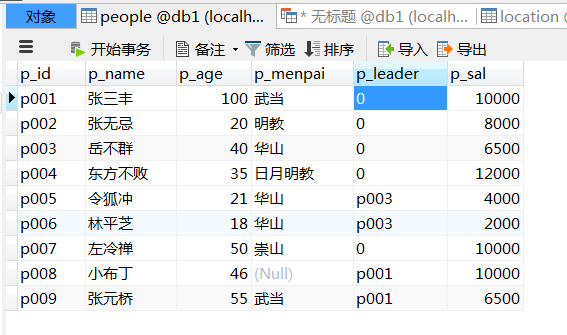-
显示数据库
show databases
-
进入指定数据库
use 数据库名称
- 创建数据库
create database 数据库名称 default character set=utf8
- 删除数据库
drop database 数据库名称
二、数据库表的操作
- 创建表:
create tabale studentinfo( name varchar(10) not null, sex char(10) null, age int(5), phone bigint(11) ) studentinfo 为所创建的表名
- 删除表
drop table 表名;
- 新增表数据
# 一次增加一条数据 insert into studentinfo (name,sex,age) values('黎诗','女','12')
# 一次增加多条数据 insert into studentinfo (name,sex,age) values('黎诗','女','21'),('诗诗','女','22') insert into 表名称 (字段名称,多个以,间隔) values (具体的值多个以,间隔)
- 修改
update studentinfo set name = '黎诗' where name = '小诗诗'
- 删除
delete from 表名 where 条件 拷贝
拷贝#拷贝表结构+记录 create table day43.user select host,user,password from mysql.user; #只拷贝表结构 create table day43.user select host,user,password from mysql.user where 1=2;
三、数据库表的简单查询(一个简单小例子)


- 查询所有人员
select * from people - 只查询人员的姓名和年龄
select p_name,p_age from people - 查询年龄为20岁的人有哪些?
select * from people where p_age = '20'
- 查询60岁一下的人员有哪些?
select * from people where p_age < '60' 查询年龄不等于60岁 的人员 select * from people where p_age <> '60' (推荐,正式) select * from people where p_age != '60' (非常规) 常见的逻辑运算符 <, >, =, <=, >=, <>, !=
- 查询50岁以上并且工资大于8000的人员有哪些?(逻辑运算符查询)
select * from people where p_age > 50 && p_sal < 8000 # 注意: and (&&)用于连接两个条件 表示并且意思 # or(||) 用于连接两个条件表示 或者意思
# 逻辑运算符: = , <, >, !=, <> , <=, >= - 查询姓张的人员(模糊查询)
select * from people where p_name LIKE '张%',
select * from prople wherer p_name LIKE '%张%' # 中间有张字的
# select * from 表名 where 字段 like '%张'
# like:表示模糊查询
# 以什么开头 : 's%'
# 以什么结尾: '%s'
# 包含: '%s%' - 查询哪些人属于武当 华山 嵩山(集合查询)
select * from people where p_menpai = '武当' or p_menpai = '华山' or p_menpai = '嵩山'; select * from people where p_menpai in ('武当','华山','嵩山'); # select * from 表名 where 字段 in('值1','值2','值3')
# in : 表示 集合
# not in:表示 反向集合 - 查询工资在5000-8900的人员有哪些?(区间查询)
select * from people where p_sal >= 5000 and p_sal <= 8900; select * from people where p_sal between 5000 and 8900;
# select * from 表名 wheere 字段 between 值1 and 值2
# 注意 : between...and... 表示区间查询 - 查询所有人员,要求工资倒序排序(排序)
select * from people where p_sal > 3000 ORDER BY p_sal desc
# asc 为正序 (默认)
# desc 为倒序 - 查询年龄为21岁人员的领导者(嵌套查询)
# select p_learder from people where p_age = '21' # selecr * from people where p_id = 'p003' select * from people where p_id = (selest p_learder from peopple where p_age = '21')
# select * from 表 where 字段 in (select 字段 from 表 where id = '值1'
# () 优先执行
# 遇到 '=' 值唯一,遇到 in 值为集合 - 查询当前人员中谁的工资最高?(嵌套函数)
# select max(p_sal) as p_sal from people
select p_name from people where p_sal = (select max(p_sal) as p_sal from people )
# max () 表示最大值
as 表示 起别名 - 查询当前人员中谁的工资最低?
select p_name from people where p_sal = (select min(p_sal) from people) SELECT p_name,p_sal from people where p_sal = (SELECT MIN(p_sal) as p_sal FROM people)
# 注意: min 为最小值 - 查询所有人员的平均工资是多少
select avg(p_sal) from people # 注意:avg()表示平均值
- 查询所有人员的工资总和是多少
select sum(p_sal) from ren # 注意 sum()求和
- 查询目前有多少个人员?
select count (p_id) from people # 注意 count(主键) 表示查询表中数据的总条数
- 查询各门派的平均工资是多少
select avg(p_sal),p_menpai,p_name from people GROUP BY p_menpai order by avg(p_sal) desc # 注意: group by 表示分组
- 查询武当派最高工资是谁
select p_name from people where p_sal = (select max(p_sal)from people where p_menpai = '武当') and p_menpai ='武当'
- 查询当前武林中有哪些门派
select p_menpai from people GROUP BY p_menpai select distinct p_menpai,p_name from people # 注意 : distinct 表示去重复查询,要求查询的所有字段必须一样,才认为是重复数据
- 查询当前武林中有哪些门派和门派的平均工资是多少
select p_menpai ,avg(p_sal) from people group by p_menpai
- 查询当前人员表的中的第3条数据到第七条数据(分页)
select * from people limit 2,5 # 注意 limit 表示分页 # 参数1 : 表示从第几条开始查询,下标从0开始 # 参数2 : 表示每次查询多少条数据
- 查询没有门派的人员有哪些?(条件时 用is null 修改时 用= null)
select * from people where p_menpai is null # 表示查询字段为null 的数据 为 is select * from people where p_menpai = '' # 表示查询字段为 ''的数据 # 别的例子 updata people set p_menpai = null where p_id = 'p_008' # 注意 修改字段为null 时,要写 =
- 查询武当派下有哪些小弟
select * from people where p_leader = (select p_id from people where p_menpai = '武当' and p_leader = '0') select * from people where p_mempai = '武当' and p_leader != '0'
- 查询各门派的工资总和按倒序/正序排列
select sum(p_sal) sal,p_menpai from people group by p_menpai order by sal - 查询人员并显示门派所在位置
select * from people,location where people.p_menpai = location.a_name
# 注意: 如果多表联合查询不加条件则会出现(笛卡尔乘积)
# : 在使用多表联合查询时,一定要加条件
# 结果: 符合两个表条件的结果 - 查询人员表,如果人员门派存在位置则显示位置信息,不存在则不显示位置
select * from people left join location on people.p_menpai = location.a_name # 左连接查询 # 注意:on 表示条件 专门配置 left join 来使用 # 特点:左表数据全要,右表的数据与左表数据相匹配则显示,不匹配则以NULL填充
- 查询位置表,如果人员的门派有位置信息则显示人员,没有则不显示
select * from people right join location on people.p_menpai = location.a_name - 查询登记了地理位置的门派人员信息
select * from people inner join location on people.p_menpai = location.a_name
